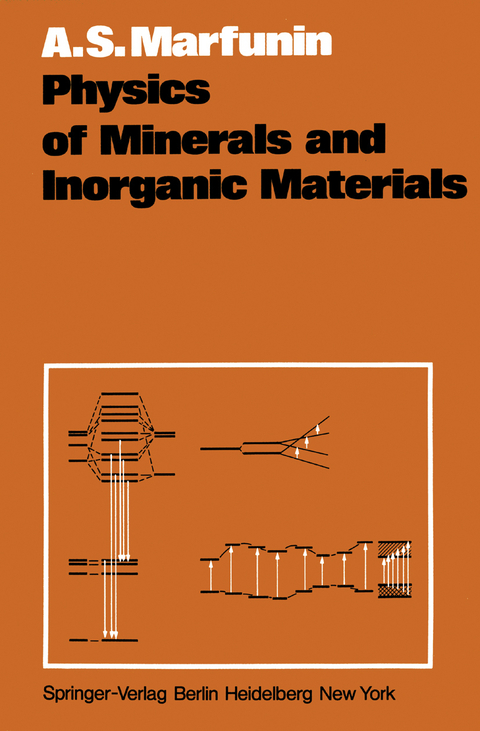
Physics of Minerals and Inorganic Materials
Springer Berlin (Verlag)
978-3-642-67046-6 (ISBN)
1 Quantum Theory and the Structure of Atoms.- 1.1 Geochemistry - History of Self-Consistent Atoms.- 1.2 The Beginnings of Quantum Theory.- 1.3 The Schrödinger Equation as the Basic Equation of Quantum Mechanics.- 1.4 Atomic Orbitals (Solutions of the Schrödinger Equation).- 1.5 Orbital Radii (Solutions of the Schrödinger Equation).- 1.6 Electron Spin.- 1.7 Electronic Configurations and the Periodic System of Elements.- 1.8 Term Symbols and Atomic States.- 2 Crystal Field Theory.- 2.1 The Actions of the Crystal Field upon the Atomic Orbitals and Terms.- 2.2 Three Types of Ion Behavior in Crystal Fields: Weak, Medium, and Strong Crystalline Fields.- 2.3 Iron Group: Term Splitting by Crystal Field.- 3 Molecular Orbital Theory.- 3.1 Introduction.- 3.2 General Theory of the Chemical Bond; Molecular Orbital Method; Valence Bond Method.- 3.3 Analysis of the MO Scheme: Information Obtained from MO and Basic Concepts of the Theory of the Chemical Bond.- 3.4 Further Development of Molecular Orbital Methods.- 4 Energy Band Theory and Reflectance Spectra of Minerals.- 4.1 Basic Principles and Methods of the Energy Band Theory.- 4.2 Analysis of the Band Schemes and Reflectance Spectra of Minerals.- 5 Spectroscopy and the Chemical Bond.- 5.1 General Outline and Parameters of Solid State Spectroscopy.- 5.2 Principal Concepts and Parameters of the Chemical Bond from the Standpoint of Spectroscopy.- 6 Optical Absorption Spectra and Nature of Colors of Minerals.- 6.1 Parameters of Optical Absorption Spectra.- 6.2 Types of Optical Absorption Spectra and Selection Rules.- 6.3 Analysis and Experimental Survey of Transition Metal Ions Spectra.- 6.4 The Nature of Colors of Minerals.- 7 Structure and the Chemical Bond.- 7.1 Contemporary Methods of Description and Calculations of theChemical Bond in Solids.- 7.2 Lattice Energy of Ionic Crystals.- 7.3 Lattice Sums, Crystal Field Parameters, Spectroscopical Parameters, and Intracrystalline Distribution.- 7.4 Atomic and Ionic, Orbital, and Mean Radii.- 8 Chemical Bond in Some Classes and Groups of Minerals.- 8.1 Diversity of the Aspects of a Complex Phenomenon of Chemical Bond in Solids.- 8.2 The Chemical Bond in Silicates.- 8.3 The Chemical Bond in Sulfides and Related Compounds.- 8.4 Features of Chemical Bonding in Other Classes of Mineral.- References.
| Erscheint lt. Verlag | 21.12.2011 |
|---|---|
| Übersetzer | N.G. Egorova, A.G. Mishchenko |
| Zusatzinfo | XII, 342 p. |
| Verlagsort | Berlin |
| Sprache | englisch |
| Maße | 170 x 244 mm |
| Gewicht | 614 g |
| Themenwelt | Naturwissenschaften ► Biologie ► Ökologie / Naturschutz |
| Naturwissenschaften ► Geowissenschaften ► Geologie | |
| Naturwissenschaften ► Geowissenschaften ► Geophysik | |
| Naturwissenschaften ► Physik / Astronomie ► Angewandte Physik | |
| Technik ► Umwelttechnik / Biotechnologie | |
| Schlagworte | Chemische Bindung • Festkörper • Materials • Mineralogie • minerals • Physics |
| ISBN-10 | 3-642-67046-6 / 3642670466 |
| ISBN-13 | 978-3-642-67046-6 / 9783642670466 |
| Zustand | Neuware |
| Haben Sie eine Frage zum Produkt? |
aus dem Bereich


